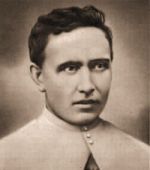Our Lady of the Eucharist
All the Marian Shrines are predominately places of Eucharistic devotion. Mary does not draw attention to herself but, like at her holy shrine of Lourdes, she is the monstrance borne aloft in the Blessed Sacrament procession.
None of this is surprising since at the Annunciation by her "Yes" to God, Mary became the first tabernacle. Had not the angel said, "You will conceive in your womb and bear a Son and you shall call His name 'Jesus' . . . The Holy Spirit will come upon you . . . Therefore, the Child to be born will be called 'holy', the Son of God" (Lk 1:31-38).
In this instant, the Eternal Word leapt down from Heaven and "He whom the whole world cannot contain enclosed Himself in your womb, O Holy Mother of God". Mary is the new Ark of the Covenant containing not just the Word of the Torah or Law, but the Eternal Word, Jesus Christ. And so the Litany of Loretto addresses her as the "Cause of our Joy, Spiritual Vessel, Vessel of Honor, Singular Vessel of Devotion" and the "House of God." She is the "Seat of Wisdom" because once born, Eternal Wisdom made her lap His throne. St. Thomas Aquinas will say her greatest honor is being the Theotokos or God Bearer. We simply express this in the West as the "Mother of God".
The Eucharist we believe to be the Body and Blood, Soul and Divinity of Our Lord Jesus Christ. He foretold this great sacrament in Chapter 6 of the Gospel of St. John and He instituted it at the Last Supper.
The flesh that was to be crucified, raised up in glory by the Father, the flesh that He gave us at the Last Supper and gives us sacramentally in the Eucharist is the flesh that He received from the Virgin Mary. Whether we think of the masterful composition by Mozart or the haunting Gregorian melody, the ancient Latin text is Ave Verum Corpus, natum de Maria Virgine and the antiphon translated is "Hail true Body, born of Mary the Virgin" and so it is! She is the Mother of the Eucharist, Our Lady of the Blessed Sacrament!
Devotion to Our Lady leads to her Son especially in the Eucharist. The devotion and practice of exposing the consecrated host in a monstrance, a vessel designed to "show" (Lt. monstrare) it. Benediction and Exposition of the Blessed Sacrament almost disappeared after Vatican II, so taken were the liturgists with the meal aspect of the Eucharist. This holy meal is also a Sacrifice representing that of the Cross and it is the Lord who is truly present as giving Himself to the Father on our behalf. St. Augustine says not only do we not sin in adoring, but we would sin if we did not!
John Paul II responded to the crisis concerning the reduction of the Eucharist to a 'meal' alone by writing Dominicae Cenae in which he emphasizes all aspects of the Eucharist as a Presence-Sacrament, a Sacrifice-Sacrament, and a Communion-Sacrament. In this document he called for Eucharistic adoration:
The Church and the World have great need of Eucharistic worship. Jesus awaits us in this sacrament of love. Let us not refuse the time to go and meet Him in adoration, in contemplation full of faith, making amends for the serious offenses and crimes of the World. Let our adoration never cease.
He heeded his own words by instituting daily exposition of the Blessed Sacrament in the four major Roman basilicas directly under his personal jurisdiction. From that moment on, Eucharistic adoration (often perpetual) has been a mighty movement of the spirit renewing parishes, religious orders, seminaries, etc. And many benefits it brings!
The great saints have written of their love for prayer before the exposed Blessed Sacrament. Priest counselors often send those with serious emotional problems to pray before the Blessed Sacrament exposed. Henri Nouwen writes movingly of the place the exposed Blessed Sacrament had at the L'Arche community in France where mentally handicapped children are cared for, and in his own personal life. Many young people are drawn to prayer. Why not train them to look at their sacramental Lord in a round sunburst monstrance while perhaps fingering rosary beads meditating on the Paschal Mystery by which we are saved. Youth 2000 does just that. It is a wonderful movement in which, after instructing the young on the truths of the Gospel and of the Faith; morality, confession, and the Mass, it then draws them to this kind of quiet prayer before the exposed Blessed Sacrament.
Love of Our Lady and The Eucharist ought to be central to the life of every Catholic Christian. For me, these two strands are symbolized in the great Polish Dominican St. Hyacinth, who when the Tartars invaded the city, went forth to meet them heading the procession of novices with the Blessed Sacrament in the monstrance. Our Lady called out from her alabaster statue, "Take me with you." St. Hyacinth responded that the statue was heavy and Our Lady answered, "My Son will make it light" and so he was able to carry it. Thus armed, the Brethren walked through the Tartar danger unscathed. And so will we if, armed with the love of Our Lord in the Eucharist and the love of His Mother, we will find that nothing can take us from God. We need the Eucharist. We need the Mother . . . the Mother of the Eucharist.
This item 6608 digitally provided courtesy of CatholicCulture.org






